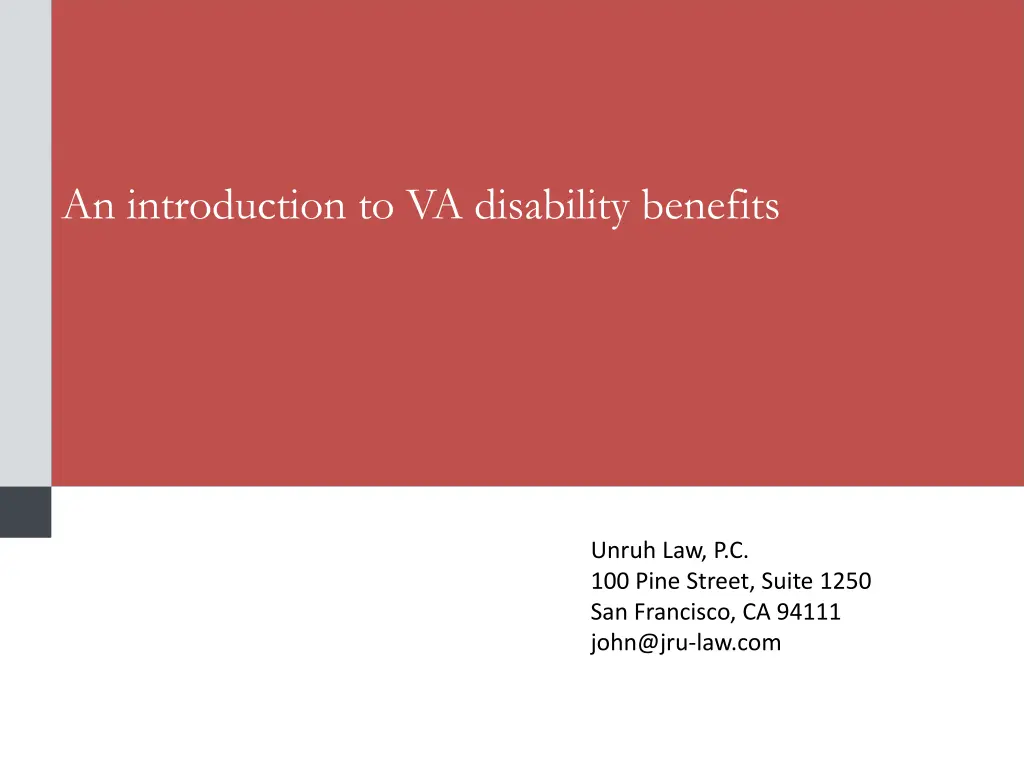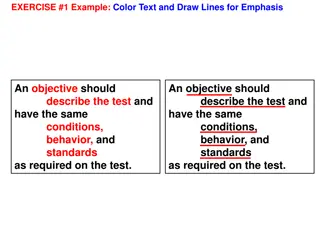
Understanding VA Disability Benefits and Eligibility Criteria
Discover the Department of Veterans Affairs (VA) disability benefits, including pensions, compensation, health care, education, and more. Learn about the basic eligibility requirements and character of discharge evaluation for veterans seeking these essential benefits.
Download Presentation

Please find below an Image/Link to download the presentation.
The content on the website is provided AS IS for your information and personal use only. It may not be sold, licensed, or shared on other websites without obtaining consent from the author. If you encounter any issues during the download, it is possible that the publisher has removed the file from their server.
You are allowed to download the files provided on this website for personal or commercial use, subject to the condition that they are used lawfully. All files are the property of their respective owners.
The content on the website is provided AS IS for your information and personal use only. It may not be sold, licensed, or shared on other websites without obtaining consent from the author.
E N D
Presentation Transcript
Introduction to Benefits for Veterans with Disabilities An introduction to VA disability benefits Unruh Law, P.C. 100 Pine Street, Suite 1250 San Francisco, CA 94111 john@jru-law.com
About Me B.A. from the University of California, Berkeley with a major in Art History, in 2001. J.D. from the The Ohio State University in 2006. Fellowship at the Legal Aid Society of Hawaii, Honolulu from 2006 to 2007, representing low-income public housing tenants in eviction proceedings. Worked as a Staff Attorney and Pro Bono Coordinator at Swords to Plowshares, a Veterans Service Organization, from 2007 to 2013, where I represented veterans applying for disability benefits from the Department of Veterans Affairs (VA). Opened my own practice in 2012 focusing on representing disabled individuals seeking employer sponsored disability benefits from private insurance companies and local, state and federal governments. I also handle bad faith cases related to individual disability policies, and I continue to represent veterans seeking benefits from the VA. Recovered over $1,000,000 in unpaid benefits on behalf of clients.
What is the Department of Veterans Affairs? Veterans Health Administration (VHA) Veterans Benefits Administration (VBA) National Cemetery Administration
VA Benefits Pension Not service-connected Means tested Compensation Service connected Not means tested Benefits for Dependents (DIC and Survivors Pension) Health Care Education and Training Home Loan Guaranty Life Insurance Burial and Memorial Services
Basic eligibility: Veteran status Federal: Army, Navy, Air Force, Marines, Coast Guard. National Guard only if federalized. Active: Reserve only if mobilized. Honorable service: A person who has served in the active military, naval or air service, and who was discharged under conditions other than dishonorable. (38 USC 101, 38 CFR 3.12(a, d), emphasis added.) No statutory bars: 38 CFR 3.12(b, c) Conscientious objector, general court martial, deserter, AWOL > 180 days unless mitigated
VA Character of Discharge evaluation Discharged or released under conditions other than dishonorable. 38 USC 101(2) Characters of service: Honorable General (under honorable conditions) Other than Honorable or Undesirable Bad Conduct Dishonorable Uncharacterized
Pension: Eligibility Veteran status. Time in service: Prior to 1980: 90 days Since September 1980 At least 24 continuous months, or Completion of time ordered to active duty, or Compensable service-connected disability. Disabled: Permanently disabled for any reason (SSI usually sufficient), or At least 65 years old. Low-income: monthly income under $1,097 (current pension rate as of 12/01/17); assets under ~ $70k. Income can be offset by some expenses, and some exempt assets. Wartime service: At least one day during a declared wartime.
Pension Wartime Periods Wartime period Start End World War II December 7, 1941 December 31, 1946 Korean Conflict June 27, 1950 January 31, 1955 Vietnam Era August 5, 1964 May 7, 1975 Vietnam Era if in theater February 8, 1961 May 7, 1975 Persian Gulf War August 2, 1990
Compensation 38 USC 1110, 1131 Compensate reduction in earning capacity caused by military service. Awarded on percentage basis, 0% 100% in 10% increments. Not each disability is ratable at each increment. Monthly payments. Tax free.
Compensation: Eligibility Veteran status. No time in service requirements. Service connection: current disability incurred or aggravated during service. Rating: evaluation of present impairment.
Compensation: Service connection To have a viable claim for service connected disability compensation you need the following three elements: An in-service event, injury, or diagnosis; plus a current disease or disability; and a nexus between the two. 1. 2. 3.
Compensation: In-service injury or illness Incurred in or aggravated during military service. As shown by: Lay evidence of event, corroborated by objective evidence. Special standards for events in combat and for PTSD. 38 CFR 3.204 (d, f) Medical evidence of illness during service. Medical evidence of illness during a presumptive period. 38 CFR 3.307, 3.309 Presumption of soundness. Not a result of willful misconduct. 38 CFR 3.301
Compensation: Current disability Current diagnosis Use DSM-V for mental disability Non-compensable: Personality disorders Adjustment disorders
Compensation: Nexus Causal relationship between in-service injury and present disability. Theories of service connection: Direct Typically requires continuity of treatment. Chronic = permanent. Does not require continuity of treatment. Presumptive No nexus required. 38 CFR 3.307-309 Secondary. Condition is a result of another condition that is already service-connected. May include substance abuse for mental health disabilities. 1151. Disability due to VA malpractice. 39 USC 1151 Competent evidence. Must be medical opinion. May use treatise evidence, but not given much weight. Standard. At least as likely as not (50% or greater).
Compensation Rates (as of 12/01/17) Compensation Rating Compensation Rating Compensation 10% $136.24 60% $1,083.52 20% $269.30 70% $1,365.48 30% $417.15 80% $1,587.25 40% $600.90 90% $1,783.68 50% $855.41 100% $2,973.86
Compensation Rates Criteria. Measures functional loss Based on schedule 38 CFR 4.40 et seq. Duration. Can be temporary or permanent Combining ratings. Consider it like a discount on a discount. 38 CFR 4.25 No pyramiding. 38 CFR 4.14 Supplements Total Disability for Individual Unemployability (TDIU). If one disability is rated 60%, or multiples add up to 70%, then may increase to 100% if combination of disabilities allows no or marginal employment. 38 CFR 4.16-17, VA Form 21-8940 Special Monthly Compensation.
Benefits for Dependents Dependency and Indemnity Compensation (DIC) Monthly benefit paid to eligible survivors. Service member who died on active duty. Veteran whose death resulted from a service connected condition. Veteran whose death did not result from a service connected condition, but who was had been receiving disability compensation and rated totally and disabled for the 10 years immediately before death. Survivors Pension ( Death Pension ) Monthly benefit for low-income unremarried surviving spouse and/or unmarried child(ren) of veteran with wartime service. Current maximum rate of $735 per month. Please note, this list is not exhaustive, so please check the regulations if contacted by a dependent.
How to make a claim? Original. (VA Form 21-526 for Pension or Compensation) Fully Developed Claim. (VA Form 21-526EZ) Reopened. Requires new and material evidence. CUE Clear and unmistakable error . a legal error in the original decision that determined an unfavorable outcome. May mean benefits are retroactive to the date of original claim.
Administrative Appeals Notice of disagreement Within 1 year of decision. State basis for disagreement. Include additional evidence or argument. DRO review and hearing are optional. Statement of the Case (SOC) Outline of issues, law and evidence. Notice of Right to Appeal. VA Form 9 Appeal to Board of Veterans Appeals . BVA hearing Single judge. Usually results in a remand to the Regional Office. If an unfavorable decision at the BVA level, an appeal is made to the Court of Appeals for Veterans Claims (CAVC), which removes the claim out of the VA Administrative System.
Overview Claims Process Informal claim Formal Claim (1 year deadline) Compensation and Pension (C&P) Exam Rating Decision Initial claim Notice of Disagreement (1 year deadline) Decision Review Officer (RDO) review. De novo. Optional. With hearing if requested. Statement of the Case (SOC) Supplementary Statement of the Case (SSOC) Regional Office appeal Form 9 (60 day deadline) BVA hearing: in person or teleconference. De novo. Decision, usually with remand. Board for Veterans Appeals (BVA) Court of Appeal for Veterans Claims (CAVC) (120 day deadline) Federal Circuit SCOTUS Judicial review
Tips and pointers Dates matter! Be sure to maintain confirmation dates of all documents submitted to the VA. The VA will misplace or lose a document you have submitted. Until you reach the BVA level, your audience is a lay person with no legal training. Write accordingly and keep it simple. Sources of authority: 38 CFR BVA and CAVC case law M21-1MR manual Check before filing if a specific form is necessary and use the most current version of any form you submit. Rely on the Disability Benefits Questionnaires (DBQ). Veterans Benefits Manual is an essential tool, published annually by LexisNexis and available at the San Francisco Law Library.
Representation of Vets: Accreditation and Fees. To assist a veteran with a claim for benefits, you must be accredited by the VA. See 38 C.F.R. 14.626, et seq. There is no cost, but there is an application process and continuing education requirements. Fees are allowed, but only after a Notice of Disagreement has been filed. A 20% contingency fee is presumed to be reasonable. A fee in excess of 20% will be more closely scrutinized by the VA. File your Fee Agreement with the VA so the VA withholds your payment.






















